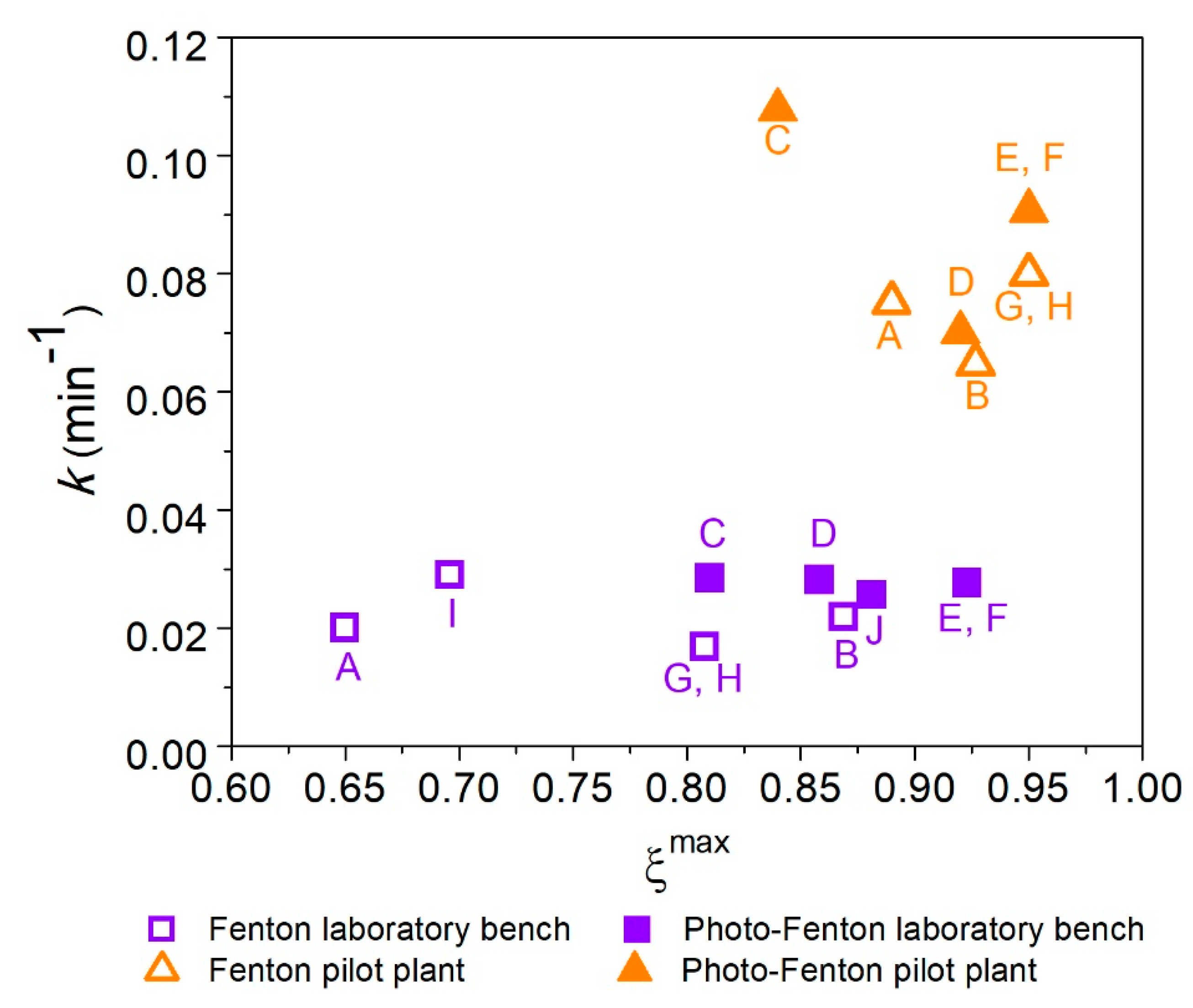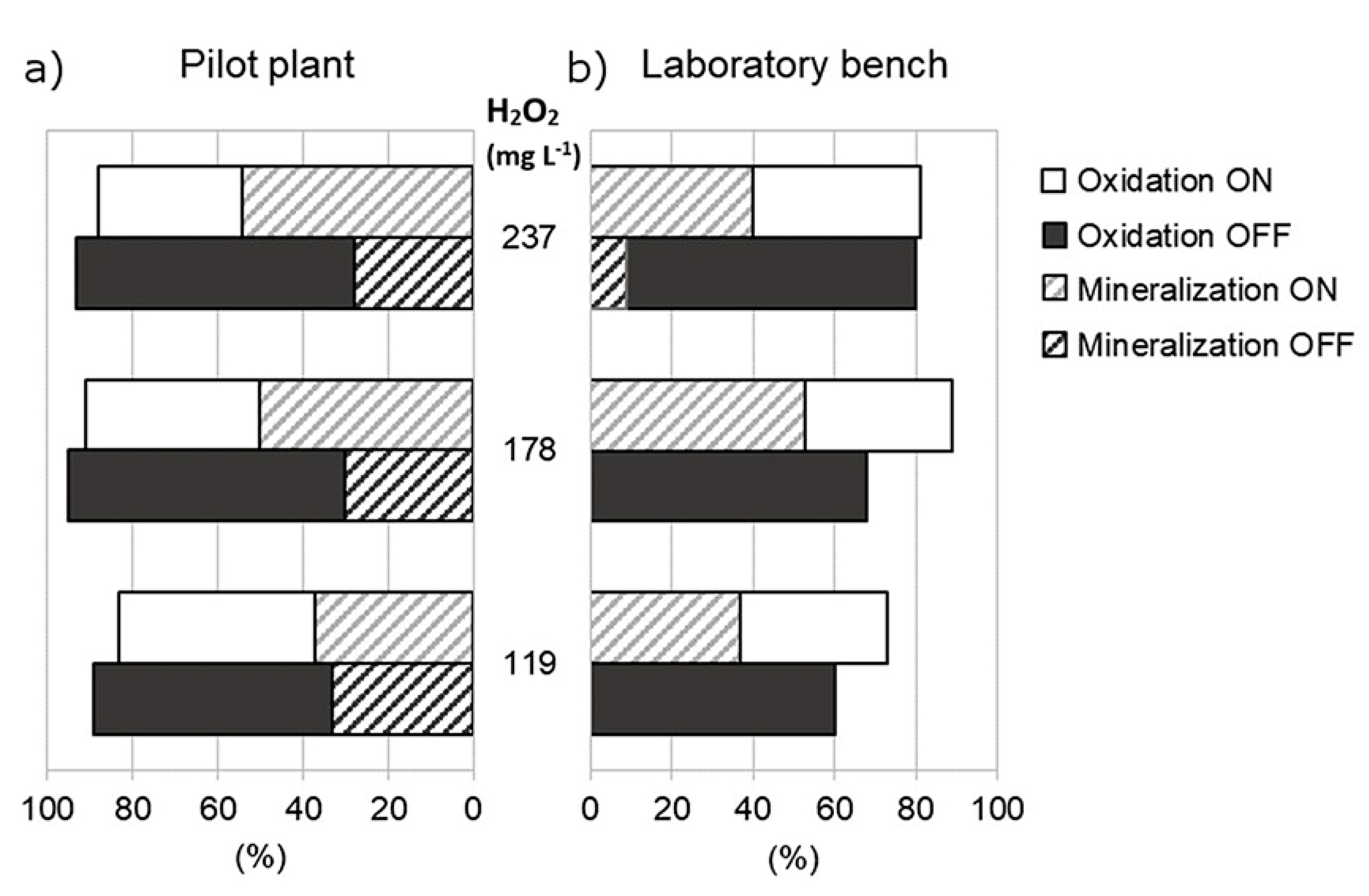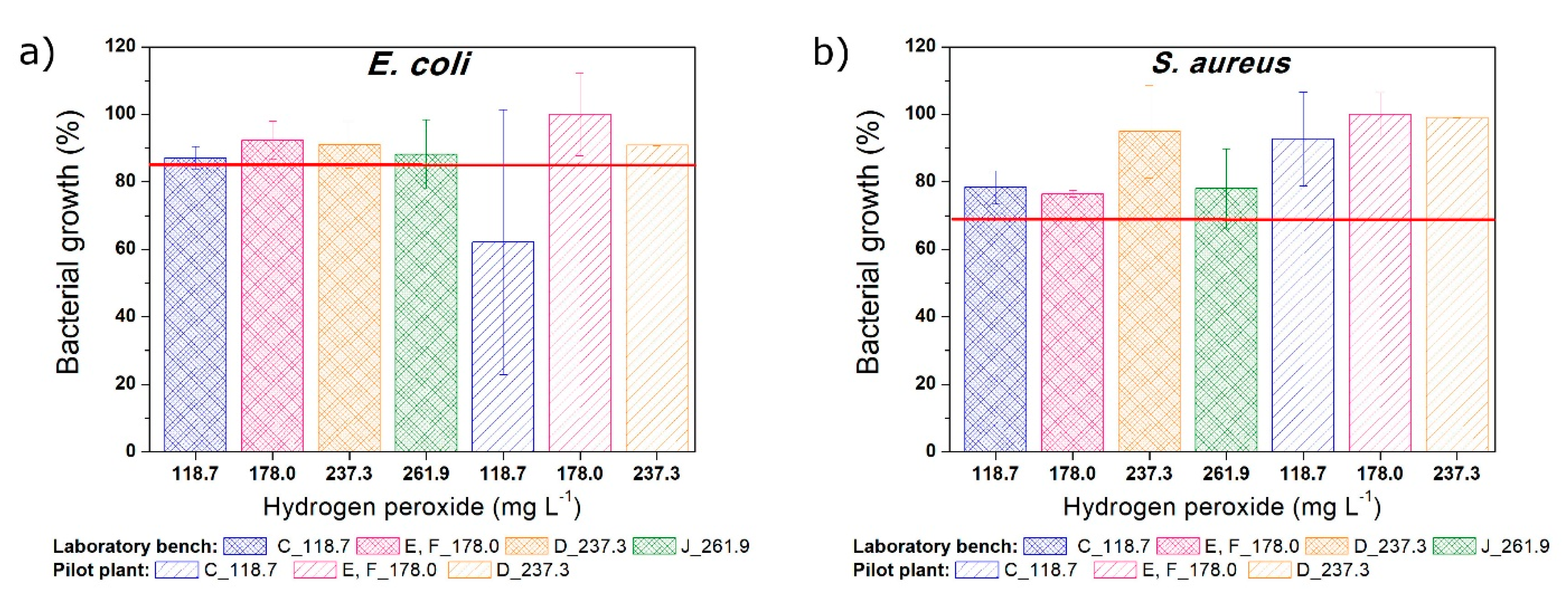Sulfaquinoxaline Oxidation and Toxicity Reduction by Photo-Fenton Process
Abstract
1. Introduction
2. Methods
2.1. Chemicals
2.2. Experimental Setups
2.2.1. Laboratory Bench
2.2.2. Pilot Plant
2.3. Experimental Conditions and Analytical Methods
2.4. Design of Experiments (DOE)
2.5. Proposed Model
3. Results and Discussion
3.1. Photolysis, Peroxidation, and Photoperoxidation of Sulfaquinoxaline
3.2. Sulfaquinoxaline Oxidation
3.3. Mineralization
3.4. Toxicity of the Solutions
3.5. Experimental Design Results
4. Conclusions
Author Contributions
Funding
Institutional Review Board Statement
Informed Consent Statement
Conflicts of Interest
References
- Baran, W.; Adamek, E.; Ziemiańska, J.; Sobczak, A. Effects of the presence of sulfonamides in the environment and their influence on human health. J. Hazard. Mater. 2011, 196, 1–15. [Google Scholar] [CrossRef] [PubMed]
- Homem, V.; Santos, L. Degradation and removal methods of antibiotics from aqueous matrices—A review. J. Environ. Manag. 2011, 92, 2304–2347. [Google Scholar] [CrossRef] [PubMed]
- García-Galán, M.J.; Garrido, T.; Fraile, J.; Ginebreda, A.; Diaz-Cruz, M.S.; Barceló, D. Application of fully automated online solid phase extraction-liquid chromatography-electrospray-tandem mass spectrometry for the determination of sulfonamides and their acetylated metabolites in groundwater. Anal. Bioanal. Chem. 2010, 399, 795–806. [Google Scholar] [CrossRef] [PubMed]
- Iglesias, A.; Nebot, C.; Miranda, J.M.; Vázquez, B.; Cepeda, A. Detection and quantitative analysis of 21 veterinary drugs in river water using high-pressure liquid chromatography coupled to tandem mass spectrometry. Environ. Sci. Pollut. Res. 2012, 19, 3235–3249. [Google Scholar] [CrossRef]
- Perret, D.; Gentili, A.; Marchese, S.; Greco, A.; Curini, R. Sulphonamide Residues in Italian Surface and Drinking Waters: A Small Scale Reconnaissance. Chromatographia 2006, 63, 225–232. [Google Scholar] [CrossRef]
- García-Galán, M.J.; Díaz-Cruz, M.S.; Barceló, D. Determination of 19 sulfonamides in environmental water samples by automated on-line solid-phase extraction-liquid chromatography–tandem mass spectrometry (SPE-LC–MS/MS). Talanta 2010, 81, 355–366. [Google Scholar] [CrossRef]
- Chang, H.; Hu, J.; Asami, M.; Kunikane, S. Simultaneous analysis of 16 sulfonamide and trimethoprim antibiotics in environmental waters by liquid chromatography–electrospray tandem mass spectrometry. J. Chromatogr. A 2008, 1190, 390–393. [Google Scholar] [CrossRef]
- De Liguoro, M.; Di Leva, V.; Gallina, G.; Faccio, E.; Pinto, G.; Pollio, A. Evaluation of the aquatic toxicity of two veterinary sulfonamides using five test organisms. Chemosphere 2010, 81, 788–793. [Google Scholar] [CrossRef]
- Dmitrienko, S.G.; Kochuk, E.V.; Apyari, V.V.; Tolmacheva, V.V.; Zolotov, Y.A. Recent advances in sample preparation techniques and methods of sulfonamides detection—A review. Anal. Chim. Acta 2014, 850, 6–25. [Google Scholar] [CrossRef]
- Preusch, P.C.; Hazelett, S.E.; Lemasters, K.K. Sulfaquinoxaline inhibition of vitamin K epoxide and quinone reductase. Arch. Biochem. Biophys. 1989, 269, 18–24. [Google Scholar] [CrossRef]
- Wang, J.; Zhuan, R. Degradation of antibiotics by advanced oxidation processes: An overview. Sci. Total Environ. 2020, 701, 135023. [Google Scholar] [CrossRef] [PubMed]
- Hassan, M.; Ashraf, G.A.; Zhang, B.; He, Y.; Shen, G.; Hu, S. Energy-efficient degradation of antibiotics in microbial electro-Fenton system catalysed by M-type strontium hexaferrite nanoparticles. Chem. Eng. J. 2020, 380, 122483. [Google Scholar] [CrossRef]
- Kümmerer, K. Antibiotics in the aquatic environment—A review—Part I. Chemosphere 2009, 75, 417–434. [Google Scholar] [CrossRef] [PubMed]
- Pignatello, J.J. Dark and photoassisted iron(3+)-catalyzed degradation of chlorophenoxy herbicides by hydrogen peroxide. Environ. Sci. Technol. 1992, 26, 944–951. [Google Scholar] [CrossRef]
- Pignatello, J.J.; Oliveros, E.; Mackay, A. Advanced Oxidation Processes for Organic Contaminant Destruction Based on the Fenton Reaction and Related Chemistry. Crit. Rev. Environ. Sci. Technol. 2006, 36, 1–84. [Google Scholar] [CrossRef]
- Rigg, T.; Taylor, W.; Weiss, J. The Rate Constant of the Reaction between Hydrogen Peroxide and Ferrous Ions. J. Chem. Phys. 1954, 22, 575–577. [Google Scholar] [CrossRef]
- Walling, C.; Goosen, A. Mechanism of the ferric ion catalyzed decomposition of hydrogen peroxide. Effect of organic substrates. J. Am. Chem. Soc. 1973, 95, 2987–2991. [Google Scholar] [CrossRef]
- Rodrigues-Silva, C.; Maniero, M.G.; Rath, S.; Guimarães, J.R. Degradation of flumequine by the Fenton and photo-Fenton processes: Evaluation of residual antimicrobial activity. Sci. Total Environ. 2013, 445, 337–346. [Google Scholar] [CrossRef]
- Perini, J.A.D.L.; Pérez-Moya, M.; Nogueira, R.F. [Unesp] P. Photo-Fenton degradation kinetics of low ciprofloxacin concentration using different iron sources and pH. J. Photochem. Photobiol. A Chem. 2013, 259, 53–58. [Google Scholar] [CrossRef]
- Ammar, H.B.; Ben Brahim, M.; Abdelhédi, R.; Samet, Y. Enhanced degradation of metronidazole by sunlight via photo-Fenton process under gradual addition of hydrogen peroxide. J. Mol. Catal. A Chem. 2016, 420, 222–227. [Google Scholar] [CrossRef]
- Alalm, M.G.; Tawfik, A.; Ookawara, S. Degradation of four pharmaceuticals by solar photo-Fenton process: Kinetics and costs estimation. J. Environ. Chem. Eng. 2015, 3, 46–51. [Google Scholar] [CrossRef]
- Liao, Q.-N.; Ji, F.; Li, J.-C.; Zhan, X.; Hu, Z.-H. Decomposition and mineralization of sulfaquinoxaline sodium during UV/H 2O2 oxidation processes. Chem. Eng. J. 2016, 284, 494–502. [Google Scholar] [CrossRef]
- Qiu, J.; He, J.; Liu, Q.; Guo, Z.; He, D.; Wu, G.; Xu, Z. Effects of Conditioners on Sulfonamides Degradation during the Aerobic Composting of Animal Manures. Procedia Environ. Sci. 2012, 16, 17–24. [Google Scholar] [CrossRef]
- Ghanem, M.; Abu-lafi, S.; Mohammad, D. Development and validation of a stability-indicating hydrophilic interaction liquid chromatograpphic method for the determination of sulfaquinoxaline sodium in water soluble powder formulation. Int. J. Pharm. Pharm. Sci. 2014, 6, 2–7. [Google Scholar]
- Urbano, V.; Peres, M.S.; Maniero, M.G.; Guimarães, J.R. Abatement and toxicity reduction of antimicrobials by UV/H2O2 process. J. Environ. Manag. 2017, 193, 439–447. [Google Scholar] [CrossRef]
- Urbano, V.R.; Maniero, M.G.; Pérez-Moya, M.; Guimarães, J.R. Influence of pH and ozone dose on sulfaquinoxaline ozonation. J. Environ. Manag. 2017, 195, 224–231. [Google Scholar] [CrossRef]
- Batista, A.P.S.; Pires, F.C.C.; Teixeira, A.C.S.C. Photochemical degradation of sulfadiazine, sulfamerazine and sulfamethazine: Relevance of concentration and heterocyclic aromatic groups to degradation kinetics. J. Photochem. Photobiol. A Chem. 2014, 286, 40–46. [Google Scholar] [CrossRef]
- Velásquez, M.; Santander, I.P.; Contreras, D.R.; Yáñez, J.; Zaror, C.; Salazar, R.A.; Pérez-Moya, M.; Mansilla, H.D. Oxidative degradation of sulfathiazole by Fenton and photo-Fenton reactions. J. Environ. Sci. Health Part A 2014, 49, 661–670. [Google Scholar] [CrossRef]
- Zhou, T.; Wu, X.; Mao, J.; Zhang, Y.; Lim, T.-T. Rapid degradation of sulfonamides in a novel heterogeneous sonophotochemical magnetite-catalyzed Fenton-like (US/UV/Fe3O4/oxalate) system. Appl. Catal. B Environ. 2014, 160–161, 325–334. [Google Scholar] [CrossRef]
- Murov, S.L.; Carmichael, I.; Hug, G.L. Handbook of Photochemistry, 2nd ed.; CRC Press Taylor & Francis Group: New York, NY, USA, 1993. [Google Scholar]
- Yamal-Turbay, E.; Ortega, E.; Conte, L.O.; Graells, M.; Mansilla, H.D.; Alfano, O.M.; Pérez-Moya, M. Photonic efficiency of the photodegradation of paracetamol in water by the photo-Fenton process. Environ. Sci. Pollut. Res. 2014, 22, 938–945. [Google Scholar] [CrossRef]
- Pérez-Moya, M.; Graells, M.; Buenestado, P.; Gutiérrez, E.; Galindo, J.; Mansilla, H.D. Modelling approach to fenton and pho-to-fenton treatments. J. Adv. Oxid. Technol. 2008, 11, 97–104. [Google Scholar]
- DOGC núm.3894, DECRET 130/2003, de 13/05/2003, (29.5.2003). Available online: https://portaljuridic.gencat.cat/eli/es-ct/d/2003/05/13/130 (accessed on 30 September 2020).
- CONAMA, Resolução 430/2011, 13/05/2011. Available online: http://www2.mma.gov.br/port/conama/legiabre.cfm?codlegi=646 (accessed on 10 October 2020).
- Marugán, J.; Hufschmidt, D.; López-Muñoz, M.-J.; Selzer, V.; Bahnemann, D.W. Photonic efficiency for methanol photooxidation and hydroxyl radical generation on silica-supported TiO2 photocatalysts. Appl. Catal. B Environ. 2006, 62, 201–207. [Google Scholar] [CrossRef]
- Nogueira, R.F.; Oliveira, M.C.; Paterlini, W.C. Simple and fast spectrophotometric determination of H2O2 in photo-Fenton reactions using metavanadate. Talanta 2005, 66, 86–91. [Google Scholar] [CrossRef] [PubMed]
- Pérez-Moya, M.; Mansilla, H.D.; Graells, M. A practical parametrical characterization of the Fenton and the photo-Fenton sulfamethazine treatment using semi-empirical modeling. J. Chem. Technol. Biotechnol. 2011, 86, 826–831. [Google Scholar] [CrossRef]
- Yamal-Turbay, E.; González, L.P.; Graells, M.; Pérez-Moya, M. Degradation of sulphamethazine by means of an improved photo-Fenton process involving a hydrogen peroxide systematic dosage. Environ. Technol. 2014, 35, 1695–1701. [Google Scholar] [CrossRef] [PubMed]
- Bona, M.D.; Di Leva, V.; De Liguoro, M. The sensitivity of Daphnia magna and Daphnia curvirostris to 10 veterinary antibacterials and to some of their binary mixtures. Chemosphere 2014, 115, 67–74. [Google Scholar] [CrossRef]
- Qiu, W.; Zheng, M.; Sun, J.; Tian, Y.; Fang, M.; Zheng, Y.; Zhang, T.; Zheng, C. Photolysis of enrofloxacin, pefloxacin and sulfaquinoxaline in aqueous solution by UV/H2O2, UV/Fe(II), and UV/H2O2/Fe(II) and the toxicity of the final reaction solutions on zebrafish embryos. Sci. Total Environ. 2019, 651, 1457–1468. [Google Scholar] [CrossRef]






| Name (Abbreviation) | Chemical Structure | Molecular Mass (g mol−1) |
|---|---|---|
| Sulfaquinoxaline sodium salt (SQX) |  | 332.32 |
| Assay | Coded Values | Variables | ||
|---|---|---|---|---|
| H2O2 | UV Radiation | H2O2 (mg L−1) | UV Radiation | |
| A | −1 | −1 | 118.7 | OFF |
| B | 1 | −1 | 237.3 | OFF |
| C | −1 | 1 | 118.7 | ON |
| D | 1 | 1 | 237.3 | ON |
| E | 0 | 1 | 178.0 | ON |
| F | 0 | 1 | 178.0 | ON |
| G | 0 | −1 | 178.0 | OFF |
| H | 0 | −1 | 178.0 | OFF |
| I | −1.414 | −1 | 94.1 | OFF |
| J | 1.414 | 1 | 261.9 | ON |
| Response Factor | Reaction Time (min) | Laboratory Bench | Pilot Plant | ||||
|---|---|---|---|---|---|---|---|
| ON/OFF | H2O2 | Interaction | ON/OFF | H2O2 | Interaction | ||
| Mineralization | 30 | 1 | |||||
| 60 | 1 | 1 | |||||
| 120 | 1 | 1 | 2 | ||||
| 240 | 1 | 1 | 3 | 2 | |||
| Oxidation | 30 | ||||||
| 60 | 1 | ||||||
| 120 | 1 | ||||||
| 240 | 1 | 2 | 1 | 2 | |||
| Setups | UV-Visible | SQX Oxidation | R2 | Mineralization | R2 |
|---|---|---|---|---|---|
| Laboratory bench | OFF | y = 0.1434x + 59.27 | 98.00% | y = 0.1441x − 18.44 | 93.72% |
| ON | y = −0.0472x + 104.18 | 98.00% | y = 0.0237x + 45.58 | 93.72% | |
| Pilot plant | OFF | y = 0.05056x + 86.50 | 95.07% | y = −0.0337x + 37.00 | 98.44% |
| ON | y = 0.05056x + 81.00 | 95.07% | y = 0.1348x + 25.50 | 98.44% |
Publisher’s Note: MDPI stays neutral with regard to jurisdictional claims in published maps and institutional affiliations. |
© 2021 by the authors. Licensee MDPI, Basel, Switzerland. This article is an open access article distributed under the terms and conditions of the Creative Commons Attribution (CC BY) license (http://creativecommons.org/licenses/by/4.0/).
Share and Cite
Urbano, V.R.; Maniero, M.G.; Guimarães, J.R.; del Valle, L.J.; Pérez-Moya, M. Sulfaquinoxaline Oxidation and Toxicity Reduction by Photo-Fenton Process. Int. J. Environ. Res. Public Health 2021, 18, 1005. https://doi.org/10.3390/ijerph18031005
Urbano VR, Maniero MG, Guimarães JR, del Valle LJ, Pérez-Moya M. Sulfaquinoxaline Oxidation and Toxicity Reduction by Photo-Fenton Process. International Journal of Environmental Research and Public Health. 2021; 18(3):1005. https://doi.org/10.3390/ijerph18031005
Chicago/Turabian StyleUrbano, Vanessa Ribeiro, Milena Guedes Maniero, José Roberto Guimarães, Luis J. del Valle, and Montserrat Pérez-Moya. 2021. "Sulfaquinoxaline Oxidation and Toxicity Reduction by Photo-Fenton Process" International Journal of Environmental Research and Public Health 18, no. 3: 1005. https://doi.org/10.3390/ijerph18031005
APA StyleUrbano, V. R., Maniero, M. G., Guimarães, J. R., del Valle, L. J., & Pérez-Moya, M. (2021). Sulfaquinoxaline Oxidation and Toxicity Reduction by Photo-Fenton Process. International Journal of Environmental Research and Public Health, 18(3), 1005. https://doi.org/10.3390/ijerph18031005








